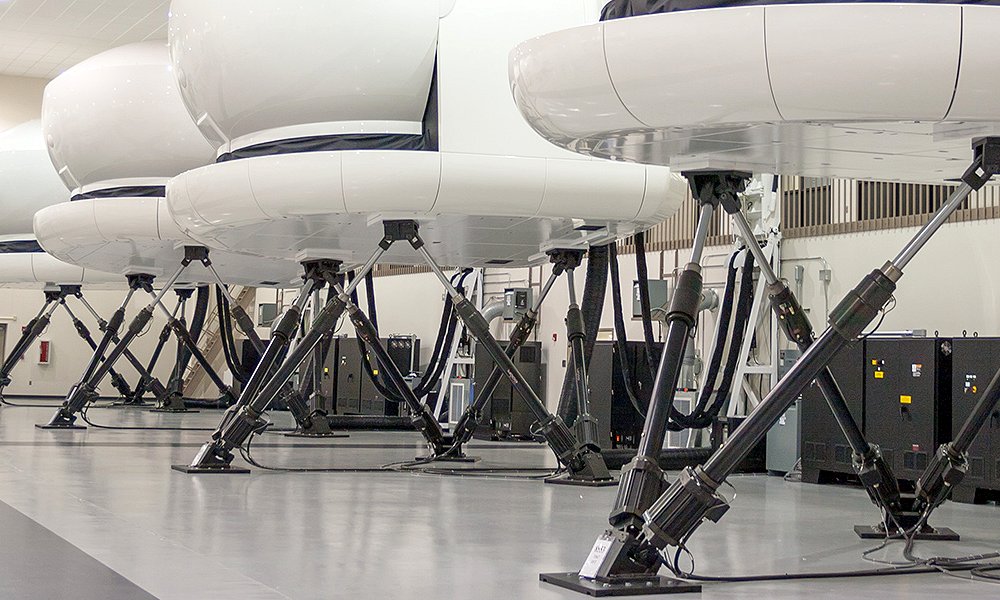
Full Motion Simulators: A Journey into Realism
What are Full Motion Simulators?
The word "simulator" was first recorded in the 1800s. It comes from the Latin word simulātor, meaning “imitator” or “counterfeiter.” It is the noun form of the verb simulate, which is derived from the Latin similis, which means “like” and is also the basis for the word similar.
Full motion simulators are advanced training devices designed to mimic the experience of a vehicle, such as an aircraft, with unparalleled accuracy. Fixed simulators rely solely on visual and auditory cues, whereas, full motion simulators incorporate physical motion, providing a comprehensive simulation of vehicle dynamics.
Components of a Full Motion Simulator:
Motion Platform:
At the heart of every full motion simulator is a sophisticated motion platform. This hydraulic or electrically powered system replicates the movements of a vehicle. The 6 degrees of freedom include: pitch, roll, heave, surge, sway and yaw. The motion platform is capable of producing precise sensations of acceleration and G-forces, enhancing the realism of the simulation.Visual System:
A high-fidelity visual system is essential for creating a realistic virtual environment. Full motion simulators often feature wraparound screens or virtual reality headsets that provide panoramic views of the simulated landscape. Advanced graphics technology ensures that details such as terrain, weather conditions, and vehicle instrumentation are faithfully reproduced.Vehicle Controls:
Authentic vehicle controls, such as steering, allow a person to interact with the simulator just as they would with a real vehicle. These controls are responsive and accurate, providing a lifelike interface for commanding the simulated vehicle.Sound System:
Immersive audio plays a crucial role in enhancing the simulation experience. Full motion flight simulators are equipped with powerful sound systems that reproduce engine noise, wind effects, and cockpit ambiance, creating an immersive experience in the virtual world.
The Advantages of Full Motion Simulators:
Realism:
Full motion simulators offer an unparalleled level of realism, providing a true-to-life simulation. The combination of motion, visuals, and sound creates an immersive experience that closely mirrors the sensations of the vehicle that is being simulated.Safety:
Vehicle training in a full motion simulator offers a safe and controlled environment to practice the trainee's skills. They can simulate emergency scenarios, adverse weather conditions, and complex maneuvers without risking injury or damage to equipment.Cost-Effectiveness:
Compared to training in real vehicle, using a full motion simulator is significantly more cost-effective. Trainees can receive certification, log hours, practice procedures, and hone their skills without the expense of fuel, maintenance, and operational overhead.Accessibility:
Full motion simulators are accessible to a wide range of users who are seeking training. These devices can be found in training centers, academia, research and development, entertainment venues, etc, providing enthusiasts with various types of opportunities.
Applications of Full Motion Simulators:
Pilot Training:
Full motion simulators are widely used in pilot training programs for commercial airlines, military forces, and private aviation. Pilots can practice procedures, refine their skills, and earn certifications in a safe and controlled environment.Research & Development:
Full motion simulators play a crucial role in different areas of research and development. Engineers use these devices to evaluate a payload's performance, test new technologies, and study human factors.Entertainment:
Beyond training and research, full motion simulators are popular attractions at aviation museums, theme parks, and entertainment centers. Enthusiasts of all ages can experience immersive simulations for many different types of applications.
Conclusion:
Full motion platforms represent the pinnacle of simulation technology. With their unparalleled realism, safety, and accessibility, these devices continue to inspire, educate, and entertain around the globe. How can InMotion Simulation help you with your simulator project?
